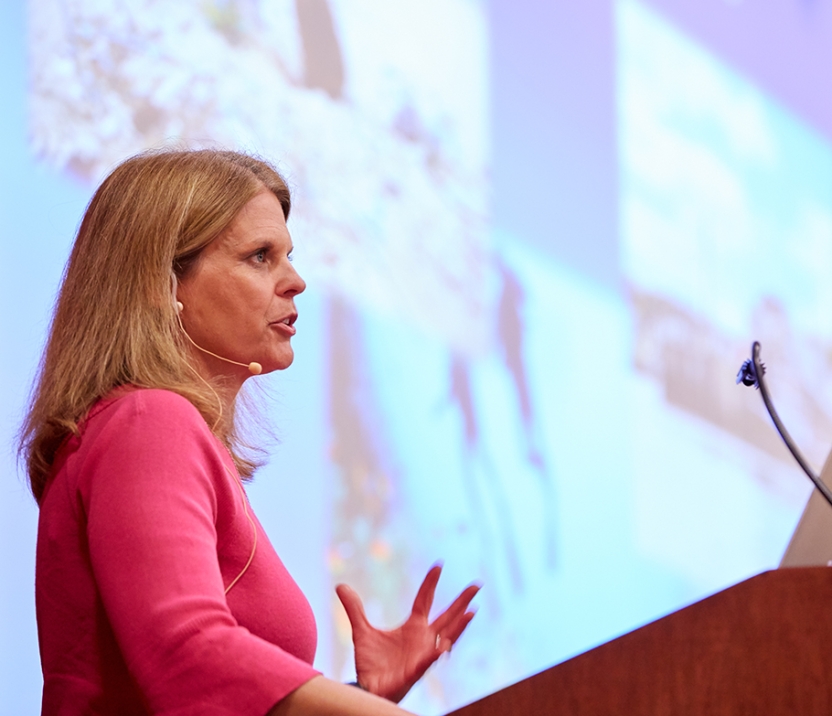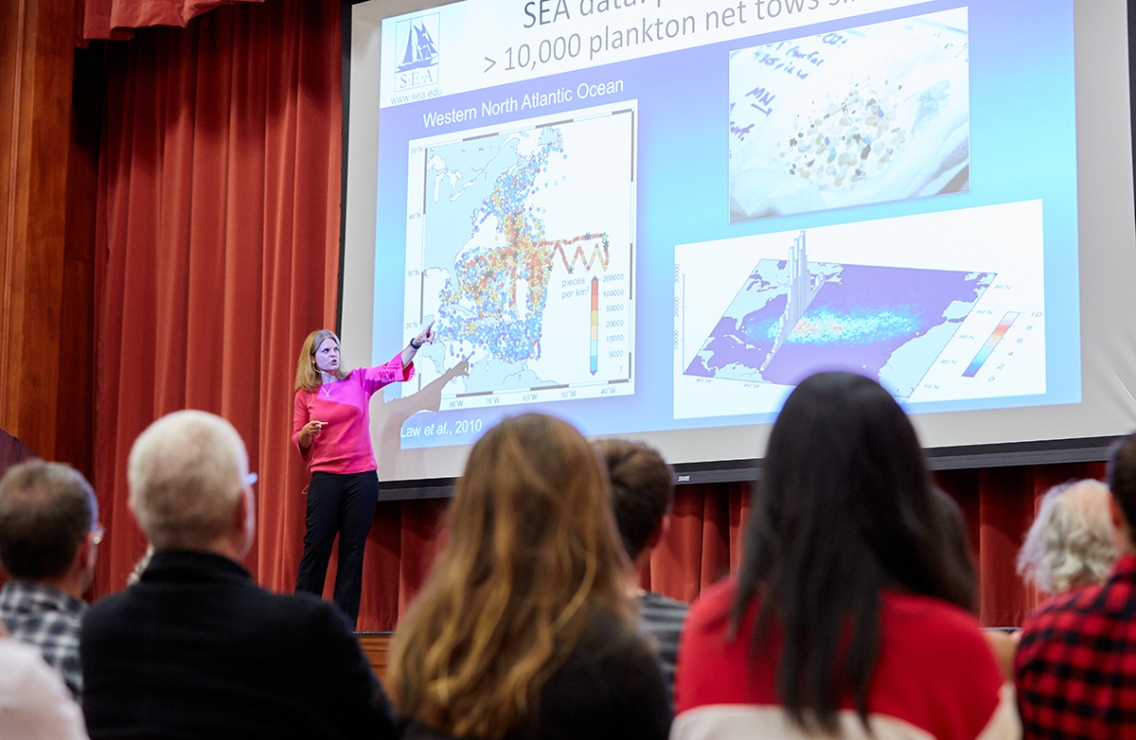It’s an ‘Unfathomable’ Amount, Says Ocean Plastics Expert

MIDDLEBURY, Vt. – Around 2007, Kara Lavender Law began hearing public reports of a floating patch of garbage in the Pacific Ocean—a great island of trash, of cast-off plastic polluting the world’s waters.
It came as a surprise to Lavender Law. As a research professor of oceanography at Sea Education Association (SEA) in Falmouth, Mass., she’d sailed and studied those waters, as had countless colleagues—not to mention decades’ worth of student researchers aboard the SEA Semester expeditions.
“There’s this concept that there’s a floating island, that there is a big landfill of trash … floating in the middle of the ocean,” said Lavender Law. “And we knew, SEA knew for decades from our experience, that there was no floating island, or if there was we hadn’t seen it yet.”
Instead, SEA researchers had found a different, no less shocking, plastic problem out in the middle of the ocean. The island of trash turned out, instead, to be a sea—literally—of microplastic particles, tiny scraps of varying sizes and shapes that had once belonged to milk cartons and plastic bags, fishing nets and detergent bottles.
They weren’t visible from the deck of the ship, the way the public imagined a garbage patch might look. But they floated there on the surface, or just beneath the surface, and they raised a lot of questions for Lavender Law: Where is this stuff accumulating, and why?

Kara Lavender Law, who gave the 2019 Clifford Symposium keynote address, is a research professor of oceanography at the Sea Education Association in Woods Hole, Massachusetts. She spoke to an audience in Wilson Hall on September 19.
Lavender Law spoke about that research, and her career as one of the leading scientists studying marine debris, on Sept. 19 in the keynote address to the annual Middlebury College Clifford Symposium, this year titled “The Future of the Global Ocean.” Lavender Law’s keynote, “Reflections of an Ocean Plastics Scientist,” spoke to the scope of the problem of plastics in the oceans, her own career path to marine debris science, and the questions that remain as scientists work to better understand the plastic crisis.
The three-day symposium included presentations by pioneering marine scientists on topics including ocean plastics, marine protected areas, and the influence of melting sea ice on weather patterns. The symposium also including the screening of Chasing the Thunder, a documentary eco-thriller that followed marine conservation society Sea Shepherd’s vessels as activists chased a notorious pirate poacher.
Forty percent of the world’s population lives within 100 kilometers of a shoreline, Lavender Law reminded her audience as she set the stage for her research. And in the last few decades, those shores have been transformed by the rapid increase in global plastic production. The production of plastics has outpaced that of any other bulk manmade materials, including cement and steel.
Researchers have estimated we’ve generated 8.3 billion metric tonnes of plastic over the time plastic has been in commercial production. “That number is unfathomable,” said Lavender Law. “I can’t even tell you a reasonable number of Empire State Buildings or elephants or football stadiums to give you an idea of how much material that is.”
More shocking still, she said, is that she and other researchers estimate that 90 percent of that plastic is still in existence on the planet—in landfills or the environment, including the oceans.
As early as 1960, scientists were documenting plastic debris in the environment. Out on the open ocean, SEA Semester students had been tracking plastic waste since the 1980s. (The reason? Faculty routinely guided student researchers toward studies that would yield results; weeks on the water might leave students without a single tuna sighting, she said, but plastic particles? Those were a sure bet.)
Working with those historic data sets, as well as new projects studying plastic debris, Lavender Law set out to investigate questions about plastics. A mathematician by training, she’d studied deep circulation while earning her PhD. Now she applied those skills to the data SEA had collected after years of dragging a plankton net behind their tall sailing ships, collecting plastics at the sea surface.
Soon, she’d discovered plastic hotspots—clusters where ocean currents converged. “You can think of it as the dead end of the ocean,” said Lavender Law. These weren’t garbage patches as the public may have imagined, but even so, researchers aboard SEA vessels were staggered by the quantity of plastic particles they brought aboard during their research in these regions.
Despite increased attention on plastic waste in the environment, Lavender Law stressed that there are still major knowledge gaps facing researchers. How much plastic debris is in the ocean? Where in the environment is it? How is plastic debris transformed in the ocean, and what is its ultimate fate? What are the impacts on marine wildlife and the ecosystem?
“Given all of this, why the hype? We don’t even understand the problem as well as we should,” Lavender Law said. “Well, there’s widespread agreement that the information we do have, the vast contamination across all parts of the ocean … is enough to have action. So the next big question is, how are we going to fix this mess?”
There’s no silver bullet yet, Lavender Law said—no way to engineer our way out of the problem. Increasingly, though, experts and policy makers are beginning to pay attention to what scientists began noticing decades ago. From meetings of the G7 and G20 to a new European Union plastics strategy, international policy leaders are putting plastics on the agenda. And Lavender Law stressed that individuals can begin by asking simple questions at work and home: What happens to my trash, recycling, and compost?
“In the end, this is a human problem,” said Lavender Law. “We created these materials, we’re creating this waste, and we now have to figure out what to do with it.”
By Kathryn Flagg ’08; Photos by Todd Balfour

